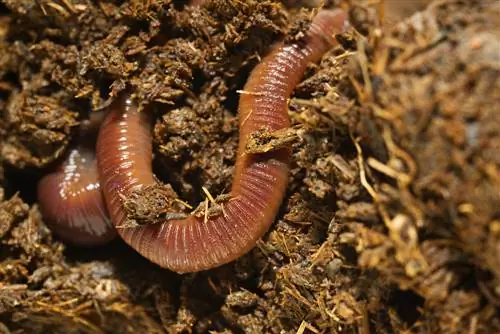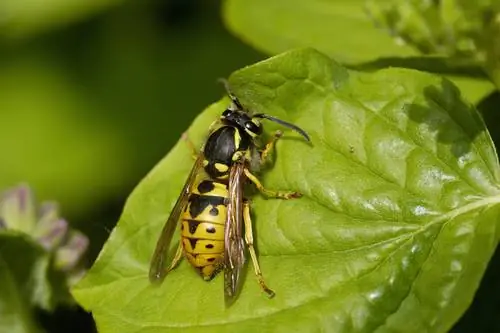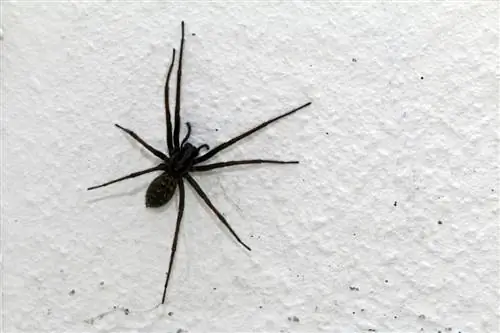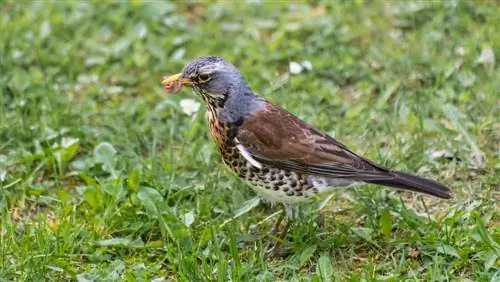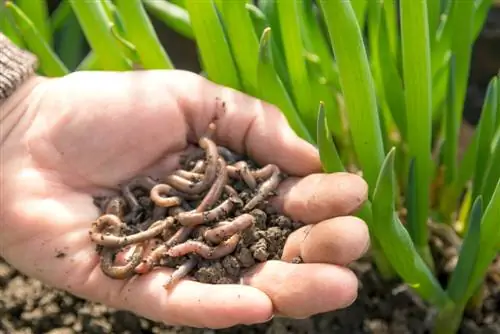- Author admin [email protected].
- Public 2023-12-16 16:46.
- Last modified 2025-06-01 06:02.
The earthworm is not an insect, even though it is an arthropod. Even in kindergarten, the little ones learn about the peculiarities of these creatures when they color the earthworm in the coloring picture or observe the animals in the worm box.

The earthworm in the profile
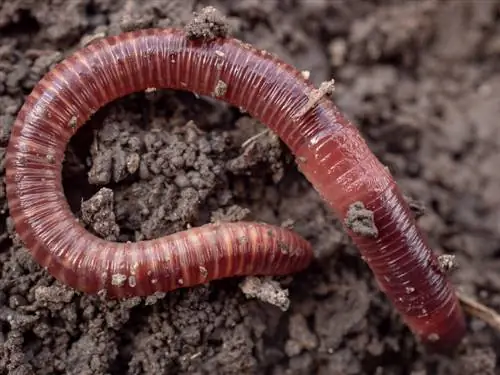
The compost worm (pictured here) is slightly smaller and redder than the common earthworm
Earthworms represent a family within the beltworms. There are currently 46 species known in Germany. The earthworm is called earthworm in English, and this name is used not only for the group of Lumbricidae but for all terrestrial worms.
One of the best-known species is the common earthworm (Lumbricus terrestris), which is nine to 30 centimeters long and is sometimes referred to as the dewworm. Another common species is the compost worm (Eisenia fetida), which is between six and 13 centimeters smaller.
Earthworms weigh an average of two grams. They become about one centimeter thick and develop a slimy protective shell to ward off harmful substances and prevent them from drying out.
Why earthworms are useful
When earthworms bore through the soil, they mix the soil particles and ensure better oxygen circulation in the substrate pores. The digging activities ensure that nutrients from the subsoil reach the roots of the plants. The droppings also provide the plants with additional nutrients. By loosening the layers of earth, rainwater can seep away better and compaction is prevented.
During the night, the creatures transport fallen leaves from the earth's surface into the underground tunnel system. This measure accelerates the decay of the plant material. The helpers not only promote soil fertility, but also improve the living conditions for numerous soil organisms.
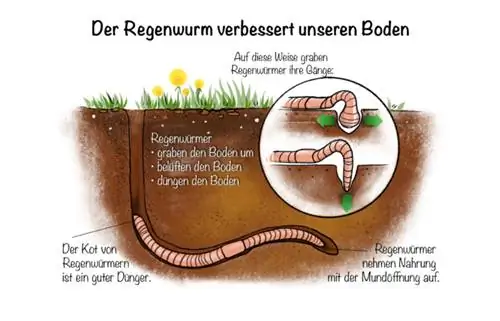
Internal and external anatomy
Earthworms consist of numerous segments that are produced throughout life by a special growth zone at the rear end. As a result, the length of a worm increases with age. When fully grown, beltworms can produce up to 160 limbs. The anatomy and structure of the body are necessary adaptations to the living space.
nervous system
Earthworms have a well-developed perception of stimuli. In cross section, the nerve pathways are reminiscent of a modified rope ladder nervous system. Paired nerve nodes, the so-called ganglia, are connected to each other by longitudinal and transverse struts. In earthworms, these components are combined to form a nerve cord, which is called the ventral cord. This main strand runs through the body on the abdominal side from the fourth segment to the tail.
Other structures of the nervous system:
- Brain (also called superior pharyngeal ganglion) in the third segment
- Subesophageal ganglion, which extends from the intestine
- three segmental nerves that branch off from the abdominal cord in each limb
Digestive system
At the head end, the earthworm has a head lobe that is curved over the mouth. This upper lip opens into a mouth opening with a direct connection to the intestine. It runs through the entire body and is divided into a muscular throat with esophagus as well as goiter and gizzard.
Earthworms are natural soil improvers because they reduce acidic soil substances through calcium-containing deposits.
The functionality is the same as with chickens. Grains of sand ingested with food grind them into pulp, which then passes through the long midgut and is excreted through the anus at the rear end.
How many hearts does an earthworm have?
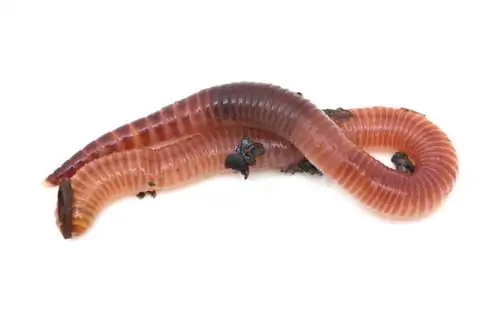
Earthworms have five hearts
The invertebrates have five pairs of hearts located in the seventh to eleventh segments. Their hearts are connected to each other and to the main blood vessels, creating a closed system. Red blood circulates in this, which is pumped through the dorsal vessel in the direction of the head and in the abdominal vessel into the rear part. The blood circulation is of particular importance because it ensures the oxygen supply to the worms.
Interesting facts:
- each heart is muscular and highly contractile
- Skin must remain moist to allow oxygen absorption
- Earthworms can also breathe in oxygen-rich water
Earthworms have no olfactory organs. Breathing takes place primarily through the skin. Further oxygen enters the intestines through the food consumed and then into the bloodstream.
Does an earthworm have eyes?
The beltworms have no eyes, but can distinguish between light and dark. This perception is made possible by light sensory cells, which are located in the epidermis at the front and back ends. Earthworms use special senses of touch and gravity to orient themselves in the darkness of the soil. They perceive gaps or obstacles and know which way is up and down. With the help of their pressure senses, the invertebrates sense ground vibrations so that they can escape in good time from approaching predators.
Locomotion
On the outside of each segment are four pairs of bristles composed of chitin and proteins. Ring-shaped and longitudinally arranged muscles enable passive movement of these appendages, allowing the worm to crawl forward and backward. The direction of movement is influenced by the position of the hair structures.
Movement sequences when crawling:
- Bristles point backwards
- anterior circular muscles contract
- Front end becomes thinner and longer
- bristles anchor rear segments in the ground
- Front part pushes towards the head
- Contraction of the longitudinal muscles backwards
- Rear end is pulled behind
In dangerous situations, muscle contractions occur more quickly. These arise, for example, when touched or by light stimuli. The worm tries to escape in an escape reaction.
From sexual intercourse to young worm
The reproduction of earthworms is a spectacular act in which both partners act as males. The female part only acts later, when the egg cocoons are produced. It can take different amounts of time for the egg to develop into a young worm.
Sexual organs
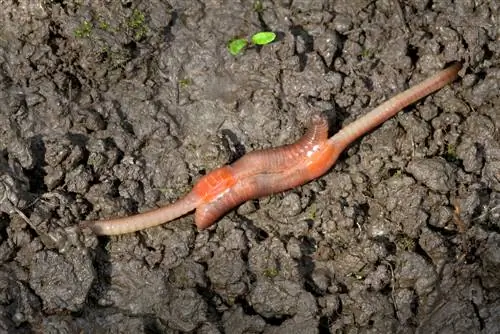
Earthworms are hermaphrodites
Earthworms do not have a specific gender. They are hermaphrodites and have both male and female sexual organs. Some earthworm species fertilize themselves, although they generally prefer sexual reproduction with a partner. You can recognize sexually mature animals by their yellowish thickening.
This belt, called the clitellum, develops between one and two years of age. It takes up a minimum of four and a maximum of 32 links and lies between the 17th and 52nd segments. The so-called puberty ridges, which form the side edges of the belt, are particularly noticeable.
When earthworms reproduce:
- no fixed times for mating
- usual breeding season between early summer and autumn
- especially from May to June
- when the temperature and moisture conditions in the soil are favorable
Earthworm reproduction
The girdle has glands that produce a secretion before mating. This is so that the sexual partners can attach themselves to each other. Both worms then excrete a portion of sperm, which is transported to the clitellum through skin movements and then stored in the partner's sperm sacs. The sperm are stored here for a few days before they fertilize the eggs.
Excursus
How often do earthworms reproduce?
Compost worms are extremely productive and mate several times per year. A cocoon can contain up to eleven eggs. In this way, a sexually mature worm produces around 300 offspring per year. In comparison to this performance, the common earthworm is a slacker, looking for a sexual partner once within twelve months and producing only five to ten cocoons, each with one egg.
Egg laying
The earthworm produces a clitellum secretion, which later solidifies and forms the parchment-like shell of the egg cocoon. He fills this protective coat with a protein-containing liquid. The animal then pulls backwards out of the cocoon ring and releases several eggs and sperm into it. Fertilization takes place outside the body in the egg. After passing the head end, the capsule closes at the ends. The cocoons of earthworms are reminiscent of yellowish to brownish fertilizer balls.
This is how earthworms lay their eggs:
- in the upper layers of the soil
- often a protective cover is also produced from feces
- likely in the compost
Development
The protein in the cocoon serves as the embryos' first food before they undergo metamorphosis into a transparent worm. Depending on the species and the outside temperature, it takes between 16 and 90 days for a fully developed baby to hatch from the egg. The embryos of dung worms develop into young worms within around two weeks at around 25 degrees. Dewworms require three months, with low temperatures of around twelve degrees in the soil being sufficient.
Identifying young worms:
- are significantly smaller than adult earthworms
- Pigmentation is very weak
- Sexual apparatus not yet present

About the life of earthworms
Earthworms are adapted to a hidden existence. They only come to the surface after heavy rainfall, or appear when digging up garden beds and compost heaps. Life on earth poses a lot of dangers.
habitat
The earthworm lives mainly in the soil. The pigmentation depends on the microhabitat in which the respective species inhabits. Worms that barely come to the soil surface are pale and pigmentless. In contrast, species that are more often observed on Earth develop UV protection in the form of dark pigmentation.
An earthworm in a flower pot did not migrate from outside. It probably comes from an egg cocoon that was in the forest or compost soil used. The terrestrial animals can survive in water-saturated soil for a few days. Boggy ground is not colonized.
Construction
As burrowers, earthworms leave extensive tunnel systems in the ground. They contract the circular muscles of the front segments and drill a hole in the ground with the thin front part. By using the longitudinal muscles, this becomes thicker and pushes the earth particles apart.
Impressive facts:
- Corridors can be up to 20 meters long in one square meter
- Earthworms are among the strongest animals in the world
- lift 50 to 60 times their own body weight when digging
Life expectancy
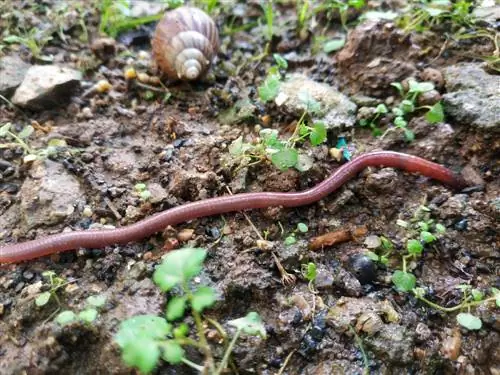
Earthworms live an average of two years
In nature, earthworms reach an average age of two years. Here their chance of survival is influenced by environmental conditions and enemies. The defenseless creatures are easy prey, which is why the number of predators is large. Many birds feed on the protein-rich soil organisms. Hedgehogs, moles, insects and amphibians are also predators. Under controlled conditions in the laboratory, some specimens lived to be ten years old.
Wintering
When the weather conditions are unfavorable, the worms seek protection in self-built burrows underground, which are filled with the body's own secretions. As cold-blooded animals, they become rigid in winter because their body temperature adapts to the ambient temperature. Long periods of cold lead to enormous weight loss. After the cold season, the worms have lost about half of their body mass, so they have to search extensively for food in the spring.
Nutrition
The beltworms have a very well-developed sense of taste. They perceive different aromas with the help of sensory buds in the oral cavity. This has an impact on the preferred food. They fill their intestines with humus-rich soil and rotting plant material through their mouths.
Tip
Place a humus box in the substrate between heavy-feeding plants in the vegetable bed. Here you can collect biological waste, which is directly decomposed by worms. Your vegetables are constantly supplied with nutrients.
Occasionally they pull seedlings and leaves underground at night so that the plant material rots. To do this, they puff up their front end and press their mouth against a leaf. A kind of suction disc holds the material in place so that the worm can transport it crawling backwards into the ground. Earthworms also absorb soil particles and decompose the bacteria, fungal spores and protozoa that live on them.
Species richness among earthworms
The common earthworm, along with the small field worm, is one of the most common species in Germany that does not belong to the same genus and is assigned to two different ecological groups:
- endogean earthworms: live in horizontal tunnels that run through the upper mineral layer
- anectic earthworms: penetrate vertical tunnels to a depth of three meters
- epigean earthworms: colonize organic layer on the soil
The compost worm belongs to the group of epigeic worms, while the anectic dew worm penetrates deeper layers of soil. A large part of all genus occurring in Germany represents the endogeic class. It also includes the small field worm.
| scientific name | colloquial | habitat | Special features | Coloring | |
|---|---|---|---|---|---|
| Common earthworm | Lumbricus terrestris | dewworm, eel worm | Meadows, gardens and orchards | only comes to the surface of the earth when there is dew | reddish at the front, pale at the back |
| Compost worm | Eisenia foetida | Stinkworm, Tennessee Wiggler | Soils with a high proportion of organic matter | Species is bred in worm farms | reddish with light to yellow rings |
| Little cankerworm | Allolobophora chlorotica | Garden worm | in heavy moist soils | lives in the upper mineral layer | pale bluish to greenish or pink |
| Red forest earthworm | Lumbricus rubellus | Red Worm, Red Leaf Eater | humus-rich soils, old tree stumps | lives on earth under leaves | solid red |
| Large cankerworm | Octolasion lacteum | - | in almost all soils | eats microorganisms on sand particles | milky blue to yellowish |
Species distribution in Germany
Towards the south, the diversity of species increases significantly, which can be attributed to the Ice Age processes. Due to the glaciation of the north, numerous species became extinct or were displaced to the ice-free zones to the south. After the ice melted, only a few species were able to migrate to northern areas. Earthworm species that are comparatively widespread live here today. In contrast, a large number of earthworms are observed in the south, which only have a limited distribution area.
Breeding earthworms
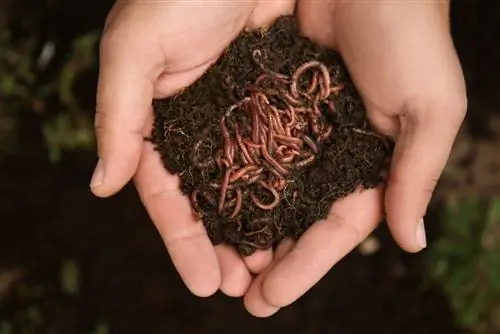
Earthworms are easy to breed
Many beltworms are easy to breed in captivity due to their low environmental requirements and high reproduction rate. So-called worm farms are used for commercial use. In private environments, the animals can be kept in worm boxes or an observation box.
Food animals
Various types of worms are available in pet stores as fishing bait or for feeding to reptiles and amphibians. Some specialized companies offer breeding kits and accessories online. Breeding animals can be purchased as adults or in egg capsule form. Since earthworms are hermaphroditic, you don't have to pay attention to gender.
Pulling worms out of egg cocoons:
- Fill the worm bin with soil, damp cardboard, newspaper or crushed coffee filters
- Place egg cocoons in the substrate
- Place the worm composter in a dark and warm place for four weeks
Soil improvement
Species with high implementation and propagation rates are suitable for use in the garden to improve soil quality. Recommended for this area of use is the compost worm, which can also be grown in a worm box. After hatching, it is recommended to place them directly in the compost heap so that the young animals have enough food. A worm composter is ideal for balconies and terraces to breed worms.
Tip
Tropical species have recently been offered to improve the soil. However, due to the neozoa problem, these are only recommended for use in closed systems such as greenhouses.
Excursus
Bizarre things from the earthworm cosmos
The longest earthworm in the world is 3.2 meters long and is found in Australia. This species from the Megascolecidae family lives in the ground, on trees or bushes. The largest earthworm discovered in China is similarly impressive and grows up to 50 centimeters long. But there are also record-breaking representatives in Germany. The Baden giant earthworm is considered the largest European species and measures between 30 and 34 centimeters when at rest. If he stretches out to his full length, his body measures 60 centimeters.
Frequently asked questions
What is an earthworm?

Earthworms are arthropods
The articulated creatures belong to the order of the few-bristled because each segment has bristles for crawling. They are not insects, even though they are arthropods like crabs, spiders and beetles. Their slimy body consists of longitudinal and circular muscles that are used for locomotion or for digging burrows.
How old does an earthworm get?
In general, the life expectancy of soil organisms is ten to twelve years. In nature, hardly any individuals reach this age because the defenseless animals have many enemies and often fall victim to environmental conditions. On average, the worms live two years in the wild. They reach sexual maturity after about a year.
Can you divide an earthworm?
The soil creatures have an extraordinary ability to regenerate and can almost completely renew their rear end after separation. Each member has the genetic predisposition to form an anus. However, the head cannot be restored. It is a rumor that a worm is separated into two individuals. Occasionally a severed posterior end forms segments with a second intestinal exit. Such an individual dies of starvation after a short time.
The front end has a chance of survival if it was separated after the 40th segment and thus has the vital lateral hearts. Since wounds often become infected in the wild, the survival rate of cut earthworms is low.
What does an earthworm eat?
The invertebrates are considered omnivores that feed on biological waste and sometimes carrion. They use the food available near the entrance to their living quarters. In addition to dead plant parts, their diet also includes microorganisms that live on rock particles. Through their activities as drill diggers, they accelerate the natural decomposition processes.
What do earthworms in the soil indicate?
Earthworms serve as bioindicators and can indicate heavy metal contamination in the soil. They absorb soil particles with mineral components and thereby accumulate metallic substances in the body. In the short term, the worms are not harmed by their accumulation in the organism. Due to their comparatively long lifespan, lumbricids can display cumulative environmental pollution over several years. The very existence of such species at a location allows certain conclusions to be drawn about soil pollution.
Can you eat earthworms?
Earthworms are becoming increasingly common for consumption. Due to the problem of parasitic organisms, this survival food should be avoided. Earthworms live symbiotically with bacteria, flagellates and ciliates. In addition, their body cavity is often infested with roundworms. Some of these species are carriers of lungworm diseases in poultry and pigs. Occasionally, the gold fly lays its eggs in earthworms so that the larvae that hatch from them find optimal feeding conditions and eat the worm from the inside as they develop.

